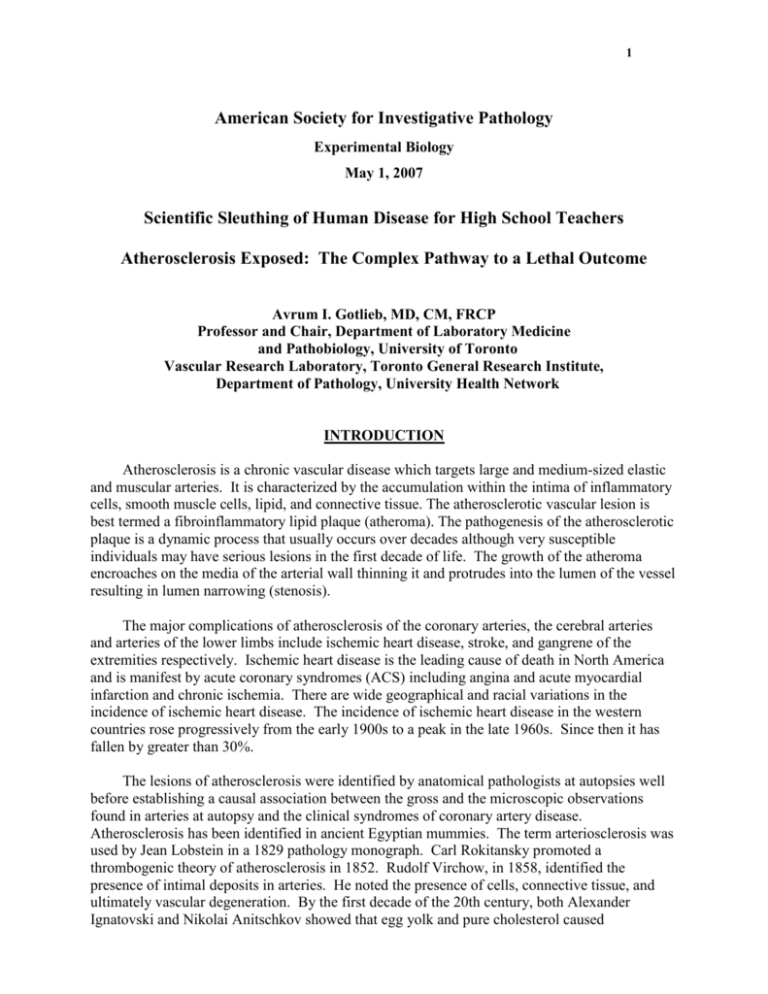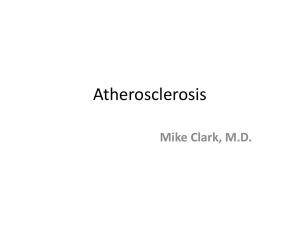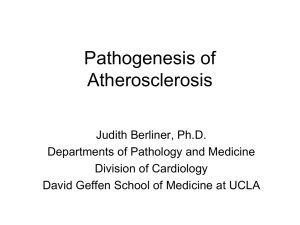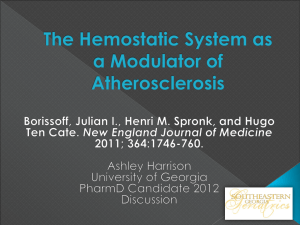Atherosclerosis is a disease of large and medium
advertisement

1 American Society for Investigative Pathology Experimental Biology May 1, 2007 Scientific Sleuthing of Human Disease for High School Teachers Atherosclerosis Exposed: The Complex Pathway to a Lethal Outcome Avrum I. Gotlieb, MD, CM, FRCP Professor and Chair, Department of Laboratory Medicine and Pathobiology, University of Toronto Vascular Research Laboratory, Toronto General Research Institute, Department of Pathology, University Health Network INTRODUCTION Atherosclerosis is a chronic vascular disease which targets large and medium-sized elastic and muscular arteries. It is characterized by the accumulation within the intima of inflammatory cells, smooth muscle cells, lipid, and connective tissue. The atherosclerotic vascular lesion is best termed a fibroinflammatory lipid plaque (atheroma). The pathogenesis of the atherosclerotic plaque is a dynamic process that usually occurs over decades although very susceptible individuals may have serious lesions in the first decade of life. The growth of the atheroma encroaches on the media of the arterial wall thinning it and protrudes into the lumen of the vessel resulting in lumen narrowing (stenosis). The major complications of atherosclerosis of the coronary arteries, the cerebral arteries and arteries of the lower limbs include ischemic heart disease, stroke, and gangrene of the extremities respectively. Ischemic heart disease is the leading cause of death in North America and is manifest by acute coronary syndromes (ACS) including angina and acute myocardial infarction and chronic ischemia. There are wide geographical and racial variations in the incidence of ischemic heart disease. The incidence of ischemic heart disease in the western countries rose progressively from the early 1900s to a peak in the late 1960s. Since then it has fallen by greater than 30%. The lesions of atherosclerosis were identified by anatomical pathologists at autopsies well before establishing a causal association between the gross and the microscopic observations found in arteries at autopsy and the clinical syndromes of coronary artery disease. Atherosclerosis has been identified in ancient Egyptian mummies. The term arteriosclerosis was used by Jean Lobstein in a 1829 pathology monograph. Carl Rokitansky promoted a thrombogenic theory of atherosclerosis in 1852. Rudolf Virchow, in 1858, identified the presence of intimal deposits in arteries. He noted the presence of cells, connective tissue, and ultimately vascular degeneration. By the first decade of the 20th century, both Alexander Ignatovski and Nikolai Anitschkov showed that egg yolk and pure cholesterol caused 2 atherosclerosis in experimental animals. The hypercholesterolemic model of atherogenesis became a well studied model, in many species, especially rabbits, and has now been successfully extended to transgenic murine models, including mouse models with features of advanced human atherosclerotic plaques and elements of plaque instability. The development of inhibitors of 3-hydroxy-3-methylglutaryl coenzyme A reductase, statins, to treated hypercholesterolemia has had a profound therapeutic affect on ACS. The recent identification of non-lipid effects of statins which target a variety of biologic processes involved in atherogenesis and plaque vulnerability has been the result of human clinical studies and experimental in vitro and in vivo studies are important advances. Alongside these lipid studies, the role of thrombosis in atherogenesis was being well studied improving the understanding of platelet structure and function, especially adhesion, aggregation and activation of platelets and of coagulation and fibrinolytic processes. Elegant, detailed morphological and clinical pathologic studies in the past 20-30 years by anatomic pathologists with an interest in the cardiovascular field provided very important new knowledge that helped to focus and design studies on pathogenesis. The major breakthrough of being able to culture pure vascular endothelial cells and smooth muscle cells, which was established in experimental pathology laboratories in the late 70's and early 80's, advanced the field rapidly. The field of atherogenesis began to utilize innovative biochemical, cellular and molecular investigations on human biologic material, experimental animal models, and in in vitro systems to direct attention to cell function, especially that of surface endothelial cells, medial smooth muscle cells, and monocyte/macrophages. The technologies that were being utilized included genomics, proteomics, clinical chemistry, and interdisciplinary approaches involving integrative biology, bioengineering, computational biology, regenerative medicine, biomaterials, and clinical imaging. Today, the intense study of endothelial and smooth muscle cell function, hemodynamic shear stress, lipid deposition, macrophage function and inflammation, immune activity, neovascularization, thrombosis, matrix remodeling and fibrous cap rupture. Investigations on the pathogenesis of atherosclerosis also led to a better understanding of the clinical conditions of acute coronary syndromes, especially in relation to the structure and function of the fibroinflammatory lipid plaque and its complications. Studies were directed at the pathogenesis, diagnosis, risk stratification and treatment using well conceived clinical practice guidelines of acute coronary syndromes, especially as they relate to thrombosis, plaque rupture, and plaque growth. In addition, the contribution of genetic risk factors to the development of ACS is being very actively studied. Pro-inflammatory gene polymorphisms have now become an important area of study to understand the development of atheromatous plaque vulnerability. Novel genetically manipulated mouse models, recently identified and characterized, that have complicated atherosclerotic plaques with characteristics similar to human vulnerable plaques are likely to become an important tool to study plaque rupture. The role of bone marrow derived stem cells and endothelial precursor cells is also a new area of research in understanding how arteries repair themselves after injury. THEORIES OF ATHEROSCLEROSIS Several theories advanced by eminent pathologists working in the field of cardiovascular pathology have been proposed to explain the initiation and growth of atherosclerotic plaques. As our knowledge increases it appears that these theories are not mutually exclusive, and are indeed linked to each other. 3 Insudation Theory: Proponents of this widely accepted theory proposed that the critical events in atherosclerosis center on the focal accumulation of fat in the vessel wall. It is believed that the lipid in these lesions is derived from plasma lipoproteins, a view consistent with the role of blood lipids as risk factors for myocardial infarction. Although there is still controversy over how the lipid accumulates in the vessel wall, the hypothesis is widely accepted. Whereas this hypothesis explains the source of plaque lipid, it does not provide a complete explanation for the pathogenesis of the atherosclerotic lesion. Since many other clinically important features of the plaque, such as smooth muscle proliferation and thrombosis, remain unexplained, lipid deposition appears to be necessary but not sufficient to explain plaque development and growth. Low-density lipoprotein (LDL) is the form of lipid in the plasma that has been most closely associated with accelerated atherosclerosis. The LDL particle is too large to penetrate the tightly closed junctions between adjacent endothelial cell. However, endothelial cells have receptors for both LDL and modified forms of LDL. Transport can occur across an intact endothelium either by receptor-mediated uptake of lipoproteins or by nonspecific uptake into micropinocytic channels. Alternatively, lipid may be engulfed by monocytes in the blood and then transported into the vascular wall inside these cells as they transmigrate into the wall between dysfunctional endothelial cells. Lipid that becomes extracellular may be trapped in the wall by altered components of the intimal matrix. Encrustation Theory: Initially supporters of this theory asserted that material from the blood was deposited on the inner surface of arteries and lead to thickening of the inner lining. Later it was thought to be the platelets and fibrin of thrombi that initiated atherosclerosis. Mural thrombosis is not the initial event in atherogenesis. However, mural thrombosis is a likely to promote the later progression of the atherosclerotic lesion and is the major event leading to vascular occlusion, especially in coronary arteries. Inflammation and Repair; A Reaction to Injury Theory: This theory was originally proposed to explain the mechanisms that lead to the accumulation of smooth muscle cells in atherosclerotic lesions. It was suggested that smooth muscle cell proliferation depends on the release of polypeptide growth factors by endothelial cells, macrophages, and smooth muscle cells themselves at sites of injury. The nature of the injury is not well understood. This theory has been broadened to focus on the role of all the cell types found in the artery wall in the initiation and growth of an atherosclerotic lesion, including dysfunctional endothelial cells and inflammatory cells; both macrophages and lymphocytes. It is suggested that the cellular responses that occur during the pathogenesis of the lesion constitute an inflammatory and a fibroproliferative response to injury. In this theory, endothelial dysfunction compromises the integrity of the endothelial barrier to macromolecules and leukocyte adhesion molecules on the surface endothelial cells are activated to promote the infiltration of macrophages into the subendothelium. The nature of the injury is likely to involve numerous factors and is different in different people depending on genetic and environmental conditions. The “reaction to injury” hypothesis evolved from the discovery that the growth of smooth muscle cells in cell culture requires one or more platelet-derived polypeptides. The best known of these is platelet-derived growth factor (PDGF), which is also secreted by both macrophages and vascular wall cells. PDGF is not only mitogenic for smooth muscle cells in vitro, but is also chemotactic for them. Thus, in addition to stimulating the proliferation of cells already located in 4 the intima, PDGF may recruit smooth muscle cells from the media. The number of growth promoters that can potentially induce proliferation of cells include fibroblast growth factor (FGF), PDGF, transforming growth factor- (TGF-), thrombin, LDL, endothelin, and others. There are also growth inhibitors, such as heparin and nitric oxide (NO). Another suggestion was that smooth muscle proliferation might be due to an aberration of growth control in one, or at most a few cells, in a manner similar to the process in a benign smooth muscle tumor. It has been established that some plaques are monoclonal; that is, they originate from one or very few smooth muscle cells. This suggests that some unknown factor, might induce fibrous cap formation by altering growth control in the smooth muscle cells of the arterial wall. Research has yet to identify possible mechanisms of monoclonality. THE THREE STAGES OF ATHEROSCLEROSIS The precursor lesions to atherosclerosis may appear as early as the fetal stage, with the formation of intimal cell masses, or perhaps shortly after birth, when fatty streaks begin to evolve. However, the characteristic fibroinflammatory lipid plaque, which is initially subclinical, usually requires 20 to 30 years to form. Once formed, serious acute complications may occur and/or complicated lesions may emerge after several more years. We can construct a hypothetical sequence divided into three stages: an initiation and formation stage, an adaptation stage and a clinical stage. The first two stages are sub-clinical so that the disease is present but does not usually produce signs or symptoms of disease. Biologically active molecules regulate a number of dynamic cellular functions. It is imbalance between proatherogenic and antiatherogenic factors and processes that leads to initiation and growth of the atherosclerotic plaque. At present, it is unlikely to identify a single atherogenic gene that explains pathogenesis. Instead multiple genes (polygenic) interacting with the environment and with each other need to be considered to understand atherogenesis. In persons at increased risk of atherosclerosis, lesions also occur in areas that are not predisposed to the disease. Stage I: Initiation and Formation The intimal lesion initially occurs at sites that are predisposed to lesion formation, owing to hemodynamic shear stress, endothelial dysfunction or the accumulation of subendothelial smooth muscle cells, as occurs in an intimal cell mass at branch points. This cell mass is considered a predisposing condition for plaque formation. The distribution of atherosclerotic lesions in large vessels, and the differences in location and frequency of lesions in different vascular beds, has supported the role of hemodynamic factors. In humans, atherosclerotic lesions tend to occur at sites where shear stresses are low but fluctuate rapidly, such as at branch points and. Hemodynamic forces induce gene expression of several factors in endothelial cells that are likely to promote atherosclerosis, including FGF-2, TF, plasminogen activator, and endothelin. However, shear stress also induces gene expression of agents that may be antiatherogenic, including nitric oxide synthase (NOS) and plasminogen activator inhibitor-1 (PAI-1). Lipid accumulation initially as a fatty streak depends on disruption of the integrity of the endothelial barrier through cell loss and/or cell dysfunction. Risk factors (see below), microorganisms, oxidized low density lipoproteins promote endothelial injury. Low density lipoproteins carry lipids into the intima. Macrophages adhere to activated endothelial cells and 5 transmigrate into the intima bringing in lipids. Some of these macrophage foam cells, undergo necrosis and release lipids. The types of connective tissue, glycosaminoglycans and proteoglycans synthesized by the smooth muscle cells in the intima also render these sites prone to lipid accumulation due to capacity of these macromolecules to trap lipids in the intima. Oxidative stress leads to cellular dysfunction and damage due to oxaclative changes in LDL in endothelial cells and macrophages. As proposed in the “reaction to injury” hypothesis, mononuclear macrophages in addition to playing a central role by participating in lipid accumulation, release growth factors, thereby stimulating further accumulation of smooth muscle cells. Oxidized lipoproteins induce tissue damage and further macrophage accumulation. Monocyte/ macrophages synthesize PDGF, FGF, TNF, IL-1, interferon- (IFN-), and TGF-, each of which can modulate the growth of smooth muscle or endothelial cells, either positively or negatively. For example, IFN- and TGF- inhibit cell proliferation and could account for the failure of endothelial cells to maintain continuity over the lesion. Alternatively, such molecules could inhibit growth-stimulatory peptides. Interlukin-1 (IL-1) and TNF stimulate endothelial cells to produce platelet-activating factor (PAF), tissue factor (TF), and PAI. Thus, the combination of macrophages and endothelial cells may transform the normal anticoagulant vascular surface to a procoagulant one. As the lesion progresses, mural thrombosis may occur on the disrupted an/or dysfunctional intimal surface. This stimulates the release of PDGF, which accelerates smooth muscle proliferation and the secretion of matrix components. The thrombus itself may grow in size, lyse, embolize or become organized and incorporated into the plaque. The deeper areas of the thickened intima are now poorly nourished by diffusion of oxygen and nutrients from the lumen and undergo necrosis, which is augmented by proteolytic enzymes released by macrophages and tissue damage caused by oxidized LDL, reactive oxygen species and other agents. This initiates neovascularization (angiogenesis) with new vessels forming in the plaque derived from the vasa vasorum. The fibroinflammatory lipid plaque is formed, with a central necrotic core and a fibrous cap which separates the core from the blood in the lumen. The plaque becomes heterogeneous with respect to inflammatory cell infiltration, lipid deposition and matrix organization. TGF is an important regulator of extracellular matrix deposition. TGF increases several types of collagen, fibronectin and proteoglycans. It inhibits proteolytic enzymes that promote matrix degradation and enhances expression of protease inhibitors. Stage II: Adaptation As the lumen is encroached upon by the extension of the plaque into the lumen. This is best seen in the coronary arteries, the wall of the artery undergoes remodeling to maintain the lumen size. Once a plaque encroaches upon half the lumen, compensatory remodeling can no longer maintain normal patency, and the lumen of the artery becomes narrowed (stenosis). Hemodynamic shear stress is an important regulator of vessel wall remodeling acting through the mechanotransduction properties of the endothelial cells. It is likely that smooth muscle cell turnover, proliferation and apoptosis, and matrix synthesis and degradation modulate remodeling of the vessel wall and the plaque. Matrix metalloproteinases (MMP) and their inhibitors, tissue inhibitors of metaloproteinases (TIMP) play important roles in this remodeling. This remodeling 6 is useful because it maintains patency of the lumen preventing ischemia, however it may delay clinical diagnosis of the presence of atherosclerosis since the plaque may be clinically silent if that there are no symptoms reported by the individual. Even though the plaque is small, plaque rupture with catastrophic results may occur at this stage, as noted below resulting in sudden death and/or acute myocardial infarction. Stage III: Clinical Plaque progression continues as the plaque protrudes into the lumen. Hemorrhage into a plaque without rupture may increase its size. The expression of HLA-DR antigens on both endothelial cells and smooth muscle cells in plaques implies that these cells have undergone some type of immunological activation, perhaps in response to IFN- released by activated T cells in the plaque. In this scenario, the presence of T cells reflects an autoimmune response that is important for the progression of atherosclerotic lesions. The antigens may include oxidized LDL to which antibodies have been identified in the plaque. Complications develop in the plaque, including surface ulceration, fissure formation, calcification, and aneurysm formation. Activated mast cells are found at sites of erosion and may release proinflammatory mediators and cytokines. Continued plaque growth leads to severe stenosis and even occlusion of the lumen. Plaque rupture, involving the fibrous cap, and ensuing thrombosis and occlusion of the lumen may precipitate acute catastrophic events in these advanced plaques. However, an important observation in angiographic studies shows that even plaques causing less than 50% stenosis may suddenly rupture, occlude the lumen and result in acute myocardial infarction and/or sudden death. MORPHOLOGY OF PRECURSOR LESIONS Fatty Streak: Fatty streaks are flat or slightly elevated yellow lesions that contain cells with intracellular accumulations of lipids. Precursor lesion of atherosclerotic lesions are lesions that create a tissue environment that predisposes to lesion formation. It is other factors that control the transition of these to the clinically significant atherosclerotic plaque. The cells are termed foam cells derived mainly from macrophages and some smooth muscle cells. Upon lysis of the cells, lipid becomes extracellular in the intima. The fatty streaks are found in young children as well as in adults and are reversible. Intimal Cell Mass: The intimal cell mass also known as “cushions,” is also considered candidate for the initial lesion of atherosclerosis. Intimal cell masses are white, thickened areas at branch points in the arterial tree. They contain smooth muscle cells and connective tissue but no lipid. The location of these lesions, at arterial branch sites correlates well with the location of later atherosclerotic lesions. MORPHOLOGY OF THE ATHEROMA Fibroinflammatory lipid plaque: The characteristic lesion of atherosclerosis is the fibroinflammatory lipid plaque. On gross examination, simple plaques are elevated, pale yellow, smooth-surfaced lesions. They are focal in distribution and irregular in shape but have well- 7 defined borders. More-advanced lesions tend to be oval, with a diameter of 8 to 12 cm and more. In smaller vessels, such as the coronary or cerebral arteries, a plaque is often eccentric; that is, it occupies only part of the circumference of the lumen. Examination of tissue sections of the atherosclerotic plaque show that is initially covered by endothelium and tends to involve the intima and only very little of the upper media. The area between the lumen and the necrotic core, termed the fibrous cap, contains smooth muscle cells, macrophages, lymphocytes, especially T cells, lipid-laden foam cells and connective tissue components. The central core contains necrotic debris. Cholesterol crystals and foreign body giant cells may be present within the fibrous tissue and the necrotic areas. Blood vessels are rare in healthy coronary arteries but plentiful in atherosclerotic plaques. This neovascularization is an important contributor to plaque growth and it is postulated that vessels grow in from the vasa vasorum. Newly formed vessels are fragile and may rupture, resulting in acute expansion of the plaque due to intraplaque hemorrhage. COMPLICATIONS OF ATHEROSCLEROSIS Complicated Atherosclerotic Plaques: A complicated plaque is characterized by erosion, ulceration or fissuring of the surface of the plaque; plaque hemorrhage; mural thrombosis; calcification; and/or aneurysm formation. Aneurysm formation: A complicated plaque extends into the media of an elastic artery and so weakens the wall to result in the formation of an aneurysm, typically in the abdominal aorta. At a certain size, these aneurysms may suddenly rupture and cause a vascular catastrophe. Calcification occurs in areas of necrosis and elsewhere in the plaque. Calcification in the artery is thought to depend on focal mineral deposition and resorption, which is regulated by osteoblast-like and osteoclast-like cells in the vessel wall. Mural thrombosis results from abnormal laminar and/or turbulent blood flow around the plaque that protrudes into the lumen. The disturbance in flow causes damage to the endothelial lining, which may become dysfunctional or locally denuded and is no longer an effective thromboresistant surface. Thrombi often form at sites of erosion and fissuring on the surface of the fibrous cap of the plaque. Mural thrombi may embolize to more distal sites. A thrombus formed over an atherosclerotic plaque may detach, become an embolism and lodge in a distal vessel. Ulceration of an atherosclerotic plaque may also dislodge atheromatous debris and produce so-called cholesterol crystal emboli, which appear as needle-shaped spaces in affected tissues, most commonly in the kidney. Vulnerable atheroma has structural and functional alterations that predispose the fibroinflammatory lipid plaque to plaque destabilization. Atheroma destabilization, resulting often in acute coronary syndromes, may occur at any time when the dynamic balance of opposing biological and physical processes is disrupted, leading to occlusive thrombosis, fibrous cap rupture, and occlusive thrombosis, or intraplaque hemorrhage and rupture. Clinically silent ruptures have been demonstrated, indicating that they can heal. Once the fibrous cap ruptures, the thrombogenic material in the plaque will usually 8 promote thrombosis in the lumen, resulting in the formation of an occlusive thrombus. Most plaques that rupture show less than 50% luminal stenosis, and over 95% display less than 70% stenosis. Plaque rupture often occurs at the shoulder of the plaque, suggesting that hemodynamic shear stress plays a role in weakening and tearing the fibrous cap. If not repaired, endothelial loss leads to erosion of the plaque, thereby weakening the fibrous cap and exposing the plaque to blood constituents. Plaque rupture has been associated with (1) areas of inflammation, (2) large lipid core size, (3) thin fibrous cap, (4) reduced number of smooth muscle cells owing to apoptosis, and (5) imbalance of proteolytic enzymes and their inhibitors in the fibrous cap, (6) calcification in the plaque, (7) intraplaque hemorrhage leading to inside-out rupture of the fibrous cap. Acute coronary syndromes: Coronary artery disease is the leading cause of mortality in the western world. Acute coronary syndromes (ACS) are characterized clinically into three groups, patients with unstable angina, those with non-ST elevation myocardial infarction (nonSTEMI) and those with ST elevation myocardial infarction (STEMI). These conditions have similar pathophysiology although each has different clinical features, therapies, and prognosis. The presence of atherothrombotic coronary artery occlusion due to plaque rupture and superimposed thrombosis with our without distal embolization is the common pathophysiology of ACS. The extent of lumen occlusion and the role of vasospasm is variable, so that patients with unstable angina may only have non-occlusive thrombi leading to reduced myocardial perfusion while those with acute myocardial infarction may have a thrombotic occlusion of the coronary artery. Plaque rupture may also heal without clinical complications. Plaque hemorrhage due to rupture of thin, newly formed vessels within the plaque, may occur within the plaque with or without a subsequent rupture of the fibrous cap. In the latter case the hemorrhage may result in expansion of the size of the plaque, thus narrowing the lumen further. The hemorrhage will be resorbed over time within the plaque, and residual hemosiderin-laden macrophages persist as evidence of a previous hemorrhage. Several circulating markers have been associated with plaque burden, including C-reactive protein, fibrinogen, soluble VCAM, IL-1, IL-6, and TNF. INTERVENTIONAL THERAPY Precutaneous transluminal coronary angioplasty is an important form of interventional therapy for stenotic atherosclerotic vascular disease, especially that of the epicardial coronary arteries. A balloon catheter is inserted into the coronary arteries, where it is inflated to dilate the stenotic artery. The balloon causes endothelial damage and tears in the atherosclerotic plaque and the media. In 30 to 40% of cases in which the vessel lumen is satisfactorily dilated, restenosis of the vessel takes place over a period of 3 to 6 months due to intimal hyperplasia due to smooth cell muscle proliferation and matrix deposition, with or without an organized mural thrombus on the luminal surface. In addition, the dynamic process of vascular wall remodeling, induced in part by the trauma to the vessel wall and involving the adventitia, also results in luminal narrowing through contraction of the vessel wall. 9 The use of stents coated with appropriate biocompatible polymers and biologically active agents began in 2002 and has resulted in less restenosis. For example, drug-eluting stents with anti-proliferative agents block cell cycle progression and thus inhibit the overgrowth of smooth muscle cells in the vessel wall. However short term and long term complications are not fully known, especially as they relate to thrombosis. Transplanted saphenous veins are used as autografts in coronary artery bypass operations in which severely stenotic arteries are bypassed. The graft extends from the proximal ascending aorta to just beyond the stenotic area of the artery. Venous grafts in place for a few years exhibit atherosclerotic plaques indistinguishable from those found in native coronary arteries. Half of these grafts occlude within 5 to 10 years, owing to neointimal hyperplasia and atherosclerosis. RISK FACTORS FOR ATHEROSCLEROSIS Any factor associated with a doubling in the incidence of ischemic heart disease has been defined as a “risk factor". A major advance in the clinical assessment and treatment of atherosclerosis is a through screening for risk factors, followed by aggressive treatment to eliminate the risk factor. Risk factors can be categorized as genetic and environmental. Hypertension: An increase in blood pressure is consistently associated with an increased risk of myocardial infarction. Although the incidence of complications of hypertension was previously attributed to the diastolic component, there is increasing evidence that the systolic pressure is equally important. In fact, men with systolic blood pressures over 160 mm Hg have almost three times the incidence of myocardial infarction as those with blood pressures under 120 mm Hg. Treatment of hypertension, which is usually clinically silent, especially in the early stages of hypertension, has resulted in a significant reduction in the incidence of myocardial infarction and stroke. Serum cholesterol level: Numerous epidemiology and clinical studies have show that the levels of serum cholesterol have been directly correlated with the incidence of ischemic heart disease. Indeed, of all the known risk factors, serum cholesterol seems to be the most important determinant of the geographical differences in the incidence of atherosclerotic coronary artery disease. In the absence of genetic disorders of lipid metabolism such as familial hypercholesterolemia, the amount of cholesterol in the blood is related to the dietary intake of saturated fat. A number of studies have demonstrated a reduction in the incidence of myocardial infarction following treatment with cholesterol-lowering drugs. Cigarette smoking: Atherosclerosis of the coronary arteries and the aorta is more severe and extensive among cigarette smokers than among nonsmokers, and the effect is dose-related. Second hand smoke is a risk factor. As a result, the incidence of myocardial infarction, ischemic stroke, and abdominal aortic aneurysms is markedly increased among smokers. Smoking is an environmental risk factor that is best addressed by eliminating smoking in preteens and teens and eliminating environments with second hand smoke. Diabetes Mellitus: Diabetics have a substantially greater risk of occlusive atherosclerotic vascular disease in many organs, but the relative contributions of carbohydrate intolerance itself, advanced glycation end-products, and secondary changes in blood lipids are not well defined. 10 The metabolic syndrome consisting of hypertension, glucose intolerance, truncal obesity and dyslipidemias has become an important target for early diagnosis and treatment. Increasing age and male gender: These factors are strong determinants of the risk for myocardial infarction. Physical inactivity and stressful life patterns: Both of these factors have been correlated with an increased risk of ischemic heart disease, although their precise relationship to the evolution of atherosclerosis is not established. Homocysteine: Homocystinuria is a rare autosomal recessive disease caused by mutations in the gene encoding cystathionine synthase. The disorder results in premature and severe atherosclerosis. Mild elevations of plasma homocysteine are common and represent an independent risk factor for atherosclerosis of the coronary arteries and other large vessels. Homocysteine is toxic to endothelial cells and inhibits several anticoagulant mechanisms in endothelial cells. It inhibits thrombomodulin on the endothelial cell surface, the antithrombin III binding activity of heparan sulfate proteoglycan, the binding of tissue plasminogen activator, and the ecto-ADPase activity on the endothelial cell surface, which promotes the aggregation of platelets. In addition, oxidative interactions between homocysteine, lipoproteins, and cholesterol have been shown. A low dietary intake of folic acid may aggravate an underlying genetic predisposition to hyperhomocysteinemia, but it has not been established that treatment with folic acid actually protects against atherosclerotic vascular disease. C-Reactive Protein and Inflammation Biomarkers: Elevated concentrations of Creactive protein (CRP), an acute phase reactant produced mainly by hepatocytes, is a marker for systemic inflammation, and has been linked to an increased risk of myocardial infarction and ischemic stroke. This finding and the presence of CRP in atherosclerotic plaque tissue suggests that systemic inflammation may indeed contribute to atherogenesis. Studies are ongoing to test the hypothesis that CRP is a causative factor in atherogenesis and to show the usefulness of CRP testing in guiding therapeutic interventions in atherosclerosis. Quality control of clinical biochemistry measurement of CRP must be rigorously applied. High sensitivity (HS) CRP is currently the measurement of choice. Another inflammatory protein under study is serum amyloid A (SAA). Other proteins associated with inflammation, such as leukocyte adhesion molecules, and fibrinogen are considered to be biomarkers of disease. Textbooks and Reviews Gotlieb AI, Silver MD. Atherosclerosis: Morphology and Pathogenesis in Cardiovascular Pathology. Silver MD, Gotlieb AI, Schoen FJ, eds New York. Third ed. ChurchillLivingstone; 2001; 68-106. Stary HC, Chandler AB, Dinsmore RE, Fuster V, Glagov S, Insull W, Rosenfeld M, Schwartz CJ, Wagner WD, Wissler RW. A definition of advanced types of atherosclerotic lesions and a histological classification of atherosclerosis. Arterioscler Thromb Vasc Biol 1995; 15:1512-1531. 11 Burke AP, Farb A, Malcom GT, Liang YH, Smialek J, Virmani R. Coronary risk factors and plaque morphology in men with coronary disease who died suddenly. N Engl J Med 1997; 336:1276-1282. Dickson BC, Gotlieb AI. Endothelial dysfunction and repair in the pathogenesis of stable and unstable fibroinflammatory atheromas. Can J Cardiology 2004; 20, Suppl B:16B-23B. Cunningham K, Gotlieb AI. The role of shear stress in atherogenesis. Lab Invest 2005; 85:9-23. Murasawa S, Asahara T. Endothelial progenitor cells for vasculogenesis. Physiology 2005; 10:36-42. Gotlieb AI. Atherosclerosis and acute coronary syndromes. Cardiovascular Pathology 14:181184, 2005. Copyright








